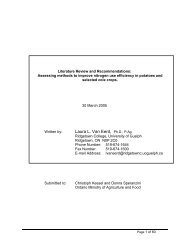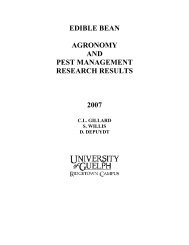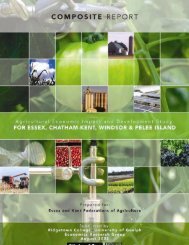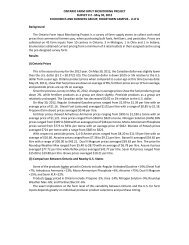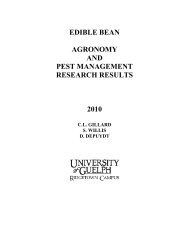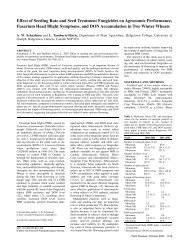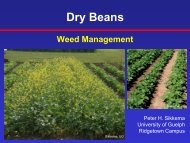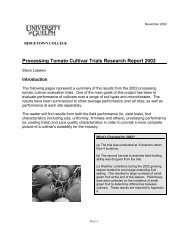Weed Management in Corn - University of Guelph
Weed Management in Corn - University of Guelph
Weed Management in Corn - University of Guelph
Create successful ePaper yourself
Turn your PDF publications into a flip-book with our unique Google optimized e-Paper software.
<strong>Weed</strong> <strong>Management</strong> <strong>in</strong> <strong>Corn</strong><br />
Questions from Farmers<br />
Peter H. Sikkema<br />
<strong>University</strong> <strong>of</strong> <strong>Guelph</strong>
Question # 1<br />
I was plann<strong>in</strong>g to plant soybeans<br />
next spr<strong>in</strong>g so I applied<br />
Guardian for perennial broadleaf<br />
weed control last fall. I changed<br />
my m<strong>in</strong>d and I would like to<br />
plant corn this spr<strong>in</strong>g. Will the<br />
corn be OK?
Visible <strong>Corn</strong> Injury (%)<br />
Fall Application <strong>of</strong> Guardian<br />
<strong>Corn</strong> Injury the Follow<strong>in</strong>g Spr<strong>in</strong>g<br />
20<br />
16<br />
12<br />
8<br />
4<br />
0<br />
7 DAE 14 DAE 28 DAE 56 DAE<br />
Sikkema, UG<br />
Control 14 g/ac 28 g/ac
Fall Application <strong>of</strong> Guardian<br />
<strong>Corn</strong> Injury the Follow<strong>in</strong>g Spr<strong>in</strong>g
<strong>Corn</strong> Yield (bu/ac)<br />
Fall Application <strong>of</strong> Guardian<br />
<strong>Corn</strong> Yield the follow<strong>in</strong>g Fall<br />
200<br />
181<br />
175 172<br />
160<br />
120<br />
80<br />
40<br />
0<br />
Yield (bu/ac)<br />
Sikkema, UG<br />
Control 14 g/ac 28 g/ac
Fall Application <strong>of</strong> Guardian<br />
Conclusions<br />
1. The fall application <strong>of</strong> Guardian results <strong>in</strong> visible<br />
<strong>in</strong>jury <strong>in</strong> corn the follow<strong>in</strong>g spr<strong>in</strong>g<br />
a. Purple discolouration<br />
b. Stunt<strong>in</strong>g<br />
2. In our studies there was a trend (9 bu/ac) to reduced<br />
yield, but it was not statistically significant
Question # 2<br />
Is weed control reduced if the<br />
herbicide is <strong>in</strong> spray solution<br />
<strong>in</strong> the sprayer for an<br />
extended period <strong>of</strong> time?
Length <strong>of</strong> Time Herbicide<br />
is <strong>in</strong> Spray Solution<br />
Introduction<br />
1. Sometimes a herbicide already is <strong>in</strong> spray<br />
solution but it cannot be spray immediately<br />
due to:<br />
a. Mechanical breakdown<br />
b. Sudden and unexpected ra<strong>in</strong><br />
c. High w<strong>in</strong>ds
Time <strong>in</strong> Solution<br />
Experiments<br />
1. Herbicides were mixed and held <strong>in</strong> solution<br />
for:<br />
a. 7 days<br />
b. 3 days<br />
c. 1 day<br />
d. 0 days
Time <strong>in</strong> Solution<br />
Herbicides Tested<br />
Preemergence<br />
Herbicides<br />
Battalion<br />
Converge<br />
Frontier + Marksman<br />
Primextra + Callisto
Time <strong>in</strong> Solution (PRE)<br />
Converge<br />
Velvetleaf<br />
Pigweed<br />
Lamb's-quarters<br />
0 20 40 60 80 100<br />
Visual <strong>Weed</strong> Control (% 8 WAA)<br />
Sikkema, UG<br />
0 days 1 day 3 days 7 days
Converge – Sprayed Immediately
Time <strong>in</strong> Solution (PRE)<br />
Yield (bu/ac)<br />
215<br />
Converge<br />
206<br />
212<br />
186<br />
100 125 150 175 200 225<br />
Sikkema, UG<br />
0 days 1 day 3 days 7 days
Time <strong>in</strong> Solution (PRE)<br />
Primextra + Callisto<br />
Velvetleaf<br />
Pigweed<br />
Lamb's-quarters<br />
0 20 40 60 80 100<br />
Visual <strong>Weed</strong> Control (% 8 WAA)<br />
Sikkema, UG<br />
0 days 1 day 3 days 7 days
Primextra + Callisto – Sprayed Immediately
Time <strong>in</strong> Solution (PRE)<br />
Summary<br />
1. When herbicides were held <strong>in</strong> spray<br />
solution for an extended period <strong>of</strong> time<br />
there was:<br />
a. No difference <strong>in</strong> pigweed control<br />
b. A decrease <strong>in</strong> lamb’s-quarters control with<br />
Converge<br />
c. A decrease <strong>in</strong> velvetleaf control with Converge<br />
and Frontier + Marksman
Time <strong>in</strong> Solution (PRE)<br />
Summary<br />
1. When herbicides were held <strong>in</strong> spray<br />
solution for an extended period <strong>of</strong> time<br />
there was (cont<strong>in</strong>ued):<br />
d. No decrease <strong>in</strong> corn yield with Frontier +<br />
Marksman, Primextra + Callisto and Battalion<br />
e. A decrease <strong>in</strong> corn yield with Converge
Time <strong>in</strong> Solution<br />
Herbicides Tested<br />
Postemergence<br />
Herbicides<br />
Callisto + Atraz<strong>in</strong>e<br />
Dist<strong>in</strong>ct<br />
Liberty<br />
Roundup
Time <strong>in</strong> Solution (POST)<br />
Dist<strong>in</strong>ct<br />
Velvetleaf<br />
Pigweed<br />
Ragweed<br />
Lamb's-quarters<br />
0 20 40 60 80 100<br />
Visual <strong>Weed</strong> Control (% 8 WAA)<br />
Sikkema, UG<br />
0 days 1 day 3 days 7 days
Time <strong>in</strong> Solution (POST)<br />
Roundup<br />
Velvetleaf<br />
Pigweed<br />
Ragweed<br />
Lamb's-quarters<br />
0 20 40 60 80 100<br />
Visual <strong>Weed</strong> Control (% 8 WAA)<br />
Sikkema, UG<br />
0 days 1 day 3 days 7 days
Liberty – Sprayed Immediately
Time <strong>in</strong> Solution (POST)<br />
Yield (bu/ac)<br />
Dist<strong>in</strong>ct<br />
Callisto + atraz<strong>in</strong>e<br />
Roundup<br />
Liberty<br />
100 125 150 175 200 225<br />
Sikkema, UG<br />
0 days 1 day 3 days 7 days
Time <strong>in</strong> Solution (POST)<br />
Summary<br />
1. When herbicides were held <strong>in</strong> spray<br />
solution for an extended period <strong>of</strong> time<br />
there was:<br />
a. No decrease <strong>in</strong> weed control with Dist<strong>in</strong>ct,<br />
Callisto + atraz<strong>in</strong>e, Roundup or Liberty<br />
b. No decrease <strong>in</strong> corn yield<br />
2. It is recommended to spray the herbicide<br />
held <strong>in</strong> solution<br />
a. Monitor field closely and re-spray if necessary
Question # 3<br />
Is there a benefit <strong>of</strong> add<strong>in</strong>g<br />
Crop Booster to<br />
glyphosate <strong>in</strong> RR corn?
No effect on weed control<br />
Crop Booster – 6 studies<br />
Lamb's-quarters<br />
Lady's thumb<br />
Nightshade<br />
Pigweed<br />
Ragweed<br />
Velvetleaf<br />
Foxtail<br />
0 20 40 60 80 100<br />
Visual <strong>Weed</strong> Control (% 8 WAA)<br />
Sikkema, UG<br />
Glyphosate<br />
Glyphosate + Crop Booster
Crop Booster on RR <strong>Corn</strong><br />
Roundup
No effect on RR corn yield<br />
Crop Booster – 6 studies<br />
Check<br />
72<br />
Glyphosate<br />
140<br />
Glyphosate + Crop<br />
Booster<br />
143<br />
0 40 80 120 160<br />
Sikkema, UG<br />
<strong>Corn</strong> Yield (bu/ac)
Crop Booster<br />
Summary<br />
1. No difference <strong>in</strong> weed control<br />
2. No difference <strong>in</strong> RR corn yield
Question # 4<br />
My corn is at the 8-10 leaf stage<br />
and I have weed escapes.<br />
Which herbicides are safest to<br />
apply at this late stage?
Late Herbicide Application <strong>in</strong> <strong>Corn</strong><br />
<strong>Corn</strong> Injury – 7 studies<br />
Accent<br />
Option<br />
Dist<strong>in</strong>ct<br />
Callisto + atraz<strong>in</strong>e<br />
Pardner + atraz<strong>in</strong>e<br />
PeakPlus<br />
Shotgun<br />
0 3 6 9 12 15<br />
Visible Crop Injury (% 2 WAA)<br />
Sikkema, UG<br />
Recommended Rate<br />
Spray Overlap
Late Herbicide Application <strong>in</strong> <strong>Corn</strong><br />
Dist<strong>in</strong>ct Injury <strong>in</strong> <strong>Corn</strong>
Late Herbicide Application <strong>in</strong> <strong>Corn</strong><br />
Decrease <strong>in</strong> <strong>Corn</strong> Height – 7 studies<br />
Accent<br />
Option<br />
Dist<strong>in</strong>ct<br />
Callisto + atraz<strong>in</strong>e<br />
Pardner + atraz<strong>in</strong>e<br />
PeakPlus<br />
Shotgun<br />
0 3 6 9 12 15<br />
Decrease <strong>in</strong> corn height (% 4 WAA)<br />
Sikkema, UG<br />
Recommended Rate<br />
Spray Overlap
Late Herbicide Application <strong>in</strong> <strong>Corn</strong><br />
<strong>Corn</strong> Yield – 7 studies<br />
Accent<br />
Option<br />
Dist<strong>in</strong>ct<br />
Callisto + atraz<strong>in</strong>e<br />
Pardner + atraz<strong>in</strong>e<br />
PeakPlus<br />
Shotgun<br />
0 40 80 120 160 200<br />
<strong>Corn</strong> Yield (bu/ac)<br />
Sikkema, UG<br />
Recommended Rate<br />
Spray Overlap
Late Herbicide Application <strong>in</strong> <strong>Corn</strong><br />
Summary<br />
1. Option results <strong>in</strong> greater <strong>in</strong>jury than Accent<br />
2. Dist<strong>in</strong>ct and Shotgun result <strong>in</strong> greater <strong>in</strong>jury<br />
than Callisto + atraz<strong>in</strong>e, Pardner and<br />
PeakPlus<br />
3. There was no effect on corn yield <strong>in</strong> these<br />
studies
Question # 5<br />
I heard about glyphosateresistant<br />
weeds.<br />
What are my weed<br />
management options <strong>in</strong> RR<br />
corn?
Roundup Ready <strong>Corn</strong><br />
Introduction<br />
1. There are many approaches to weed management<br />
<strong>in</strong> Roundup Ready corn<br />
a. Yield was maximized when Roundup was applied before<br />
weeds were 10 cm <strong>in</strong> height 1<br />
b. Pr<strong>of</strong>itability was maximized with one early postemergence<br />
application <strong>of</strong> Roundup 2<br />
2. BUT, the over-reliance on Roundup has resulted <strong>in</strong><br />
the selection <strong>of</strong> glyphosate resistant weed biotypes<br />
or weeds naturally tolerant to glyphosate <strong>in</strong> other<br />
jurisdictions<br />
1<br />
Nelson, 2007<br />
2<br />
Thomas et al. 2007
Roundup Ready <strong>Corn</strong><br />
<strong>Weed</strong> <strong>Management</strong> Strategies<br />
1. One application <strong>of</strong> Roundup applied early<br />
postemergence (EP)<br />
2. One application <strong>of</strong> Roundup applied late<br />
postemergence (LP)<br />
3. A tankmix <strong>of</strong> Roundup plus a residual herbicide<br />
(Marksman) applied EP<br />
4. A sequential application <strong>of</strong> a preemergence (PRE)<br />
residual herbicide (Converge) followed by Roundup<br />
applied LP<br />
5. A sequential application <strong>of</strong> Roundup applied EP and<br />
LP
<strong>Weed</strong> Control (%)<br />
Roundup Ready <strong>Corn</strong><br />
Velvetleaf Control – 8 WAA<br />
100<br />
93<br />
98<br />
99 99 99 100 98 99<br />
80<br />
70<br />
60<br />
40<br />
38<br />
20<br />
0<br />
Roundup EP Roundup LP Roundup +<br />
Marksman EP<br />
Converge PRE;<br />
Roundup LP<br />
Roundup EP;<br />
Roundup LP<br />
Sikkema, UG<br />
Nurse, AAFC<br />
Env # 1 Env # 2
Roundup Ready <strong>Corn</strong><br />
Roundup + Marksman EP<br />
Sikkema, UG
<strong>Weed</strong> Control (%)<br />
Roundup Ready <strong>Corn</strong><br />
100<br />
Pigweed Control – 8 WAA<br />
93<br />
100 100 100 100<br />
80<br />
60<br />
40<br />
20<br />
0<br />
Roundup EP Roundup LP Roundup +<br />
Marksman EP<br />
Converge PRE;<br />
Roundup LP<br />
Roundup EP;<br />
Roundup LP<br />
Sikkema, UG<br />
Nurse, AAFC<br />
Pooled across environments
<strong>Weed</strong> Control (%)<br />
Roundup Ready <strong>Corn</strong><br />
Lamb’s-quarters Control – 8 WAA<br />
100 100 100 100 99 100<br />
100<br />
91 91<br />
80<br />
60<br />
71<br />
78<br />
40<br />
20<br />
0<br />
Roundup EP Roundup LP Roundup +<br />
Marksman EP<br />
Converge PRE;<br />
Roundup LP<br />
Roundup EP;<br />
Roundup LP<br />
Sikkema, UG<br />
Nurse, AAFC<br />
Ridgetown A-2006<br />
Exeter-2007
Roundup Ready <strong>Corn</strong><br />
Converge PRE; Roundup LP<br />
Sikkema, UG
<strong>Weed</strong> Control (%)<br />
Roundup Ready <strong>Corn</strong><br />
100<br />
Green Foxtail Control – 8 WAA<br />
97<br />
100 99 98 97 99 100 99<br />
80<br />
71<br />
60<br />
40<br />
45<br />
20<br />
0<br />
Roundup EP Roundup LP Roundup +<br />
Marksman EP<br />
Converge PRE;<br />
Roundup LP<br />
Roundup EP;<br />
Roundup LP<br />
Sikkema, UG<br />
Nurse, AAFC<br />
Harrow - 2007 Ridgetown A-2007
Yield (T/ha)<br />
Roundup Ready <strong>Corn</strong><br />
200<br />
160<br />
200<br />
Yield (bu/ac)<br />
191<br />
194 196 199<br />
180<br />
120<br />
80<br />
40<br />
0<br />
<strong>Weed</strong>-free Roundup EP Roundup LP Roundup +<br />
Marksman EP<br />
Converge<br />
PRE;<br />
Roundup LP<br />
Roundup EP;<br />
Roundup LP<br />
Sikkema, UG<br />
Nurse, AAFC<br />
Average <strong>of</strong> 11 studies
Roundup LP<br />
Sikkema, UG<br />
Roundup LP<br />
Sikkema, UG
Pr<strong>of</strong>it Marg<strong>in</strong> ($/ac)<br />
Roundup Ready <strong>Corn</strong><br />
Pr<strong>of</strong>it Marg<strong>in</strong>s<br />
750<br />
747<br />
739<br />
718<br />
700<br />
698<br />
689<br />
650<br />
642<br />
650<br />
620<br />
618<br />
600<br />
584<br />
550<br />
Roundup EP Roundup LP Roundup +<br />
Marksman EP<br />
Converge PRE;<br />
Roundup LP<br />
Roundup EP;<br />
Roundup LP<br />
Vyn, UG<br />
Ridgetown B-2007<br />
Exeter-2007
Roundup Ready <strong>Corn</strong><br />
Conclusions<br />
1. <strong>Weed</strong> management is field specific<br />
2. The most consistent weed control was provided by<br />
the two-pass programs<br />
a. Residual herbicide (PRE) fb glyphosate (LP)<br />
b. A sequential application <strong>of</strong> glyphosate applied EP fb LP
Roundup Ready <strong>Corn</strong><br />
Comments<br />
1. Due to the possibility <strong>of</strong> glyphosate-resistant<br />
weeds or weed shifts, the follow<strong>in</strong>g are<br />
recommended:<br />
a. A diverse crop rotation<br />
b. Inclusion <strong>of</strong> multiple herbicide modes-<strong>of</strong>action<br />
a. Preemergence residual followed by<br />
glyphosate postemergence<br />
b. Postemergence tankmix <strong>of</strong> glyphosate +<br />
another effective herbicide
Question # 6<br />
When is the best time to apply<br />
glyphosate <strong>in</strong> RR corn?
Roundup Ready <strong>Corn</strong><br />
Application Tim<strong>in</strong>g<br />
1. There is a temptation to delay the application<br />
until all the weeds have emerged
<strong>Weed</strong> Control (%)<br />
Roundup Ready <strong>Corn</strong><br />
Application Tim<strong>in</strong>g<br />
100<br />
80<br />
60<br />
40<br />
20<br />
0<br />
Sikkema, UG<br />
Spike 1 leaf 2 leaf 3 leaf 4 leaf<br />
Velvetleaf Pigweed Foxtail, Green
Yield (bu/ac)<br />
Roundup Ready <strong>Corn</strong><br />
Roundup - Application Tim<strong>in</strong>g (20 sites)<br />
150<br />
143<br />
141<br />
139<br />
140<br />
138<br />
136<br />
133<br />
131<br />
129<br />
130<br />
127<br />
120<br />
110<br />
100<br />
Hamill, AAFC<br />
Sikkema, UG<br />
<strong>Weed</strong><br />
Free<br />
1 2 3 4 5 6 7 8<br />
<strong>Corn</strong> Leaf Stage<br />
Average <strong>of</strong> 20 experiments
Roundup Ready <strong>Corn</strong><br />
Roundup - Application Tim<strong>in</strong>g<br />
Delay <strong>in</strong><br />
Application<br />
(Days)<br />
1<br />
3<br />
7<br />
10<br />
Yield Loss<br />
(bu/ac)<br />
0.5<br />
1.5<br />
3.5<br />
5.0<br />
Value<br />
($/ac)<br />
2.00<br />
6.00<br />
14.00<br />
20.00
Roundup Ready <strong>Corn</strong><br />
Application Tim<strong>in</strong>g<br />
1. Early application is recommended<br />
a. Improved control<br />
b. Reduced weed <strong>in</strong>terference<br />
c. Increased corn yield<br />
2. <strong>Weed</strong> management is always field specific<br />
a. The appropriate application tim<strong>in</strong>g ranged<br />
from the 1 to 8-leaf stage <strong>in</strong> our<br />
experiments
Question # 7<br />
What is the effect <strong>of</strong><br />
glyphosate drift on<br />
conventional corn?
Glyphosate Drift
Visible <strong>Corn</strong> Injury (%)<br />
Glyphosate Drift<br />
<strong>Corn</strong> Injury – 14 days after drift occurred<br />
60<br />
52<br />
50<br />
40<br />
30<br />
20<br />
10<br />
0<br />
20<br />
9<br />
0 1<br />
Control 1% 5% 10% 20%<br />
Glyphosate Concentration (%)<br />
Brown, UG<br />
Average <strong>of</strong> 9 experiments (ON, OH, IN, IL)
<strong>Corn</strong> Yield (bu/ac)<br />
Glyphosate Drift<br />
200<br />
150<br />
<strong>Corn</strong> Yield<br />
157 152 147<br />
125<br />
100<br />
76<br />
50<br />
0<br />
1% 9% 20%<br />
52%<br />
Control 1% 5% 10% 20%<br />
Glyphosate Concentration (%)<br />
Brown, UG<br />
Average <strong>of</strong> 12 experiments (ON, OH, IN, IL)
<strong>Corn</strong> Yield (bu/ac)<br />
Glyphosate Drift<br />
200<br />
<strong>Corn</strong> Yield<br />
3% 6% 20% 52%<br />
150<br />
157 152 147<br />
125<br />
100<br />
76<br />
50<br />
0<br />
1% 9% 20%<br />
52%<br />
Control 1% 5% 10% 20%<br />
Glyphosate Concentration (%)<br />
Brown, UG<br />
Average <strong>of</strong> 12 experiments (ON, OH, IN, IL)
Glyphosate Drift<br />
Conclusions<br />
1. There are large differences <strong>in</strong> <strong>in</strong>jury and yield loss<br />
from one field to another due to:<br />
a. Concentration <strong>of</strong> the drift<br />
b. Size <strong>of</strong> the corn at the time the drift occurred<br />
c. Weather conditions prior to and after the drift event<br />
d. <strong>Management</strong> after the drift event occurred<br />
2. <strong>Corn</strong> yield loss ranged from 0 to almost 100% due to<br />
glyphosate drift <strong>in</strong> these studies
Question # 8<br />
Does the time <strong>of</strong> day that I<br />
spray have an effect on<br />
weed control?
<strong>Weed</strong> Control (%) 8 WAA<br />
Time <strong>of</strong> Day<br />
100<br />
80<br />
79<br />
Pardner<br />
92 92<br />
81<br />
60<br />
61<br />
40<br />
20<br />
30<br />
24<br />
0<br />
6 am 9 am 12 pm 3 pm 6 pm 9 pm 12 am<br />
Velvetleaf Control
<strong>Corn</strong> Yield (bu/ac)<br />
Time <strong>of</strong> Day<br />
175<br />
Pardner<br />
150<br />
125<br />
143 144 144<br />
148<br />
142<br />
135<br />
125<br />
100<br />
100<br />
75<br />
50<br />
25<br />
0<br />
<strong>Weed</strong>y 6 am 9 am 12 pm 3 pm 6 pm 9 pm 12 am<br />
<strong>Corn</strong> Yield (2 experiments at Ridgetown)
<strong>Weed</strong> Control (%) 8 WAA<br />
Time <strong>of</strong> Day<br />
100<br />
80<br />
88<br />
Liberty<br />
97 96 96<br />
76<br />
68<br />
60<br />
40<br />
20<br />
18<br />
0<br />
6 am 9 am 12 pm 3 pm 6 pm 9 pm 12 am<br />
Velvetleaf Control
<strong>Weed</strong>y Check 6 am 9 am<br />
Liberty<br />
Time <strong>of</strong> Day<br />
12 pm<br />
3 pm<br />
6 pm 9 pm 12 am
<strong>Corn</strong> Yield (bu/ac)<br />
Time <strong>of</strong> Day<br />
200<br />
Liberty<br />
160<br />
138 141<br />
154 152<br />
145<br />
137<br />
120<br />
93<br />
115<br />
80<br />
40<br />
0<br />
<strong>Weed</strong>y 6 am 9 am 12 pm 3 pm 6 pm 9 pm 12 am<br />
<strong>Corn</strong> Yield (2 Experiments at Ridgetown)
<strong>Weed</strong> Control (%) 8 WAA<br />
Time <strong>of</strong> Day<br />
100<br />
Roundup<br />
98 98 98 98 98 95<br />
80<br />
82<br />
60<br />
40<br />
20<br />
0<br />
6 am 9 am 12 pm 3 pm 6 pm 9 pm 12 am<br />
Velvetleaf Control
<strong>Weed</strong>y Check 6 am 9 am<br />
Roundup<br />
Time <strong>of</strong> Day<br />
12 pm<br />
3 pm<br />
6 pm 9 pm 12 am
Time <strong>of</strong> Day<br />
Summary – Herbicides<br />
Herbicide > 10% Difference %<br />
Pardner 7 out <strong>of</strong> 9 78<br />
Liberty 7 out <strong>of</strong> 13 54<br />
Atraz<strong>in</strong>e 2 out <strong>of</strong> 4 50<br />
Accent 2 out <strong>of</strong> 6 33<br />
Dist<strong>in</strong>ct 2 out <strong>of</strong> 12 17<br />
Roundup 1 out <strong>of</strong> 7 14
Time <strong>of</strong> Day<br />
Summary – <strong>Weed</strong> Species<br />
<strong>Weed</strong> Species > 10% Difference %<br />
Velvetleaf 8 out <strong>of</strong> 12 67<br />
Lamb’s-quarters 6 out <strong>of</strong> 14 43<br />
Pigweed 2 out <strong>of</strong> 5 40<br />
Barnyard grass 2 out <strong>of</strong> 5 40<br />
Common ragweed 4 out <strong>of</strong> 11 36<br />
Green foxtail 1 out <strong>of</strong> 3 33
Time <strong>of</strong> Day<br />
Summary<br />
1. Change <strong>in</strong> efficacy dur<strong>in</strong>g the day is thought to be<br />
affected by:<br />
a. Air temperature – 9.5-11.5 O C (Mart<strong>in</strong>son et al. 2002)<br />
i. Less viscous epicuticular wax (Price, 1983)<br />
ii. Increased membrane permeability (Anderson et al., 1993)<br />
iii. Increase <strong>in</strong> rates <strong>of</strong> diffusion (Price, 1993)<br />
iv. Increased enzyme activity and metabolic processes (Price, 1993)<br />
b. Leaf angle – decrease <strong>in</strong> spray <strong>in</strong>terception and retention -<br />
85% (Andersen and Koukkari, 1978; Mart<strong>in</strong>son et al,<br />
2002)
Leaf orientation dur<strong>in</strong>g the day<br />
Leaf orientation dur<strong>in</strong>g the night
Time <strong>of</strong> Day<br />
Conclusions<br />
2. The effect <strong>of</strong> time <strong>of</strong> day on herbicide efficacy is<br />
dependent on:<br />
a. Herbicide<br />
i. Pardner, Liberty and Aatrex were affected the most<br />
ii. Accent, Dist<strong>in</strong>ct and Roundup were affected the least<br />
b. <strong>Weed</strong> species<br />
i. Velvetleaf was affected the most<br />
ii. Green foxtail was affected the least<br />
c. Environment<br />
i. Velvetleaf control with glyphosate varied 1, 1 and 16% <strong>in</strong> 2005,<br />
2006 and 2007 respectively<br />
3. The level <strong>of</strong> weed control due to time <strong>of</strong> application<br />
can affect corn yield
That’s confus<strong>in</strong>g, now what do I do?<br />
Actually, there is a silver l<strong>in</strong><strong>in</strong>g. The<br />
herbicides with greatest potential<br />
for <strong>of</strong>f-site <strong>in</strong>jury (systemic<br />
herbicides) are affected the least<br />
by time <strong>of</strong> day. So apply them<br />
when weed speeds are lowest.
That’s confus<strong>in</strong>g, now what do I do?<br />
Contact herbicides which are<br />
more sensitive to time <strong>of</strong> day<br />
have less potential for <strong>of</strong>f-site<br />
<strong>in</strong>jury. Apply them dur<strong>in</strong>g the<br />
warmest, brightest sunlit hours<br />
<strong>of</strong> the day.
<strong>Weed</strong> <strong>Management</strong> <strong>in</strong> <strong>Corn</strong><br />
Questions from Farmers<br />
Peter H. Sikkema<br />
<strong>University</strong> <strong>of</strong> <strong>Guelph</strong>



